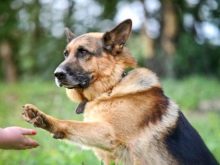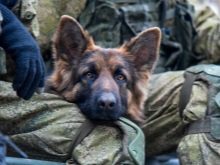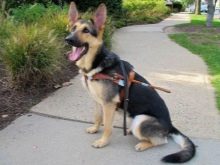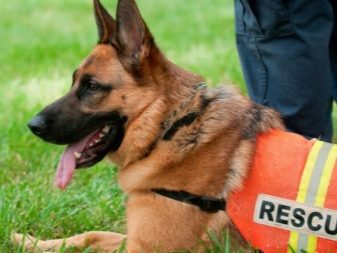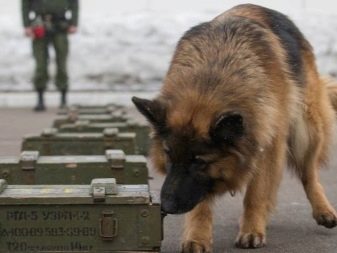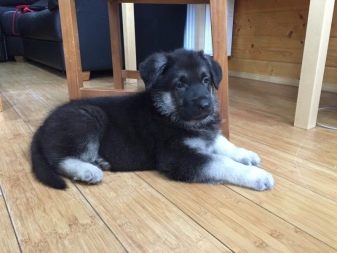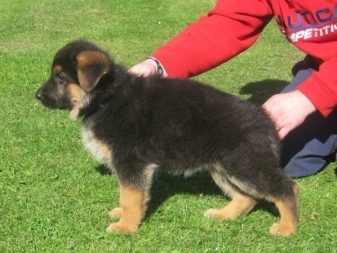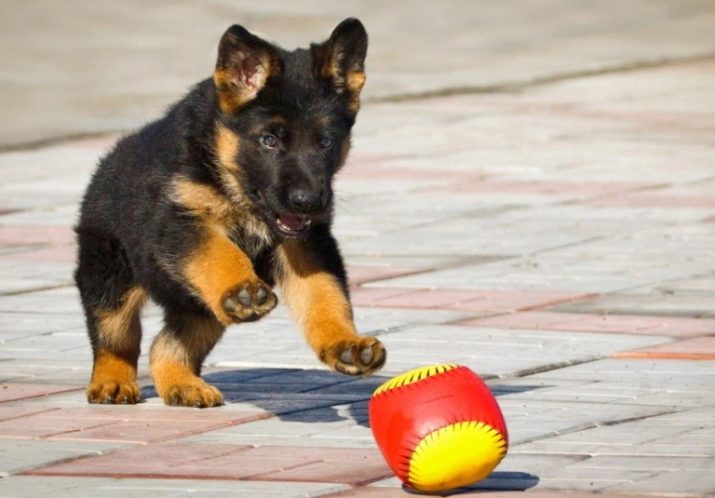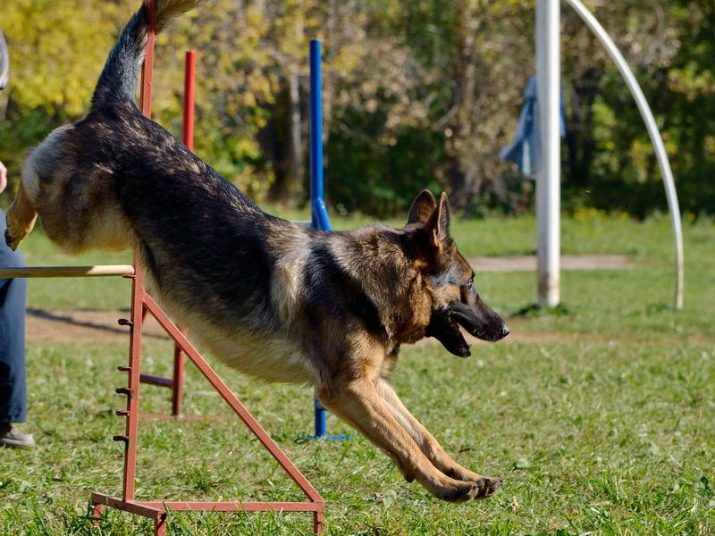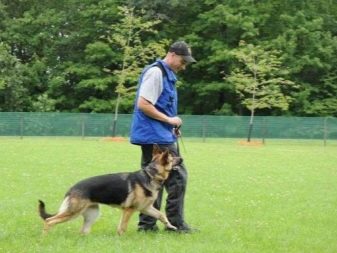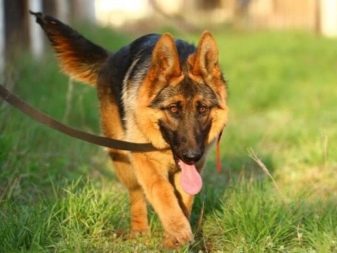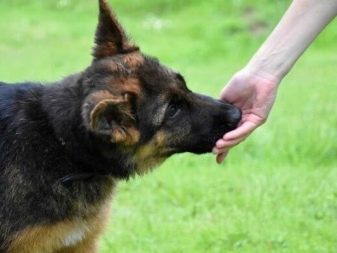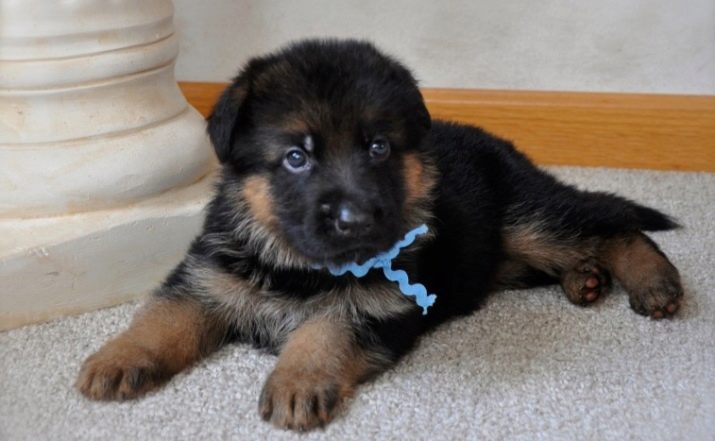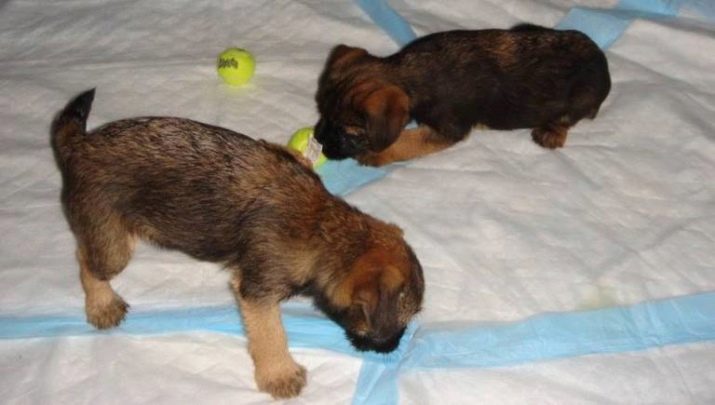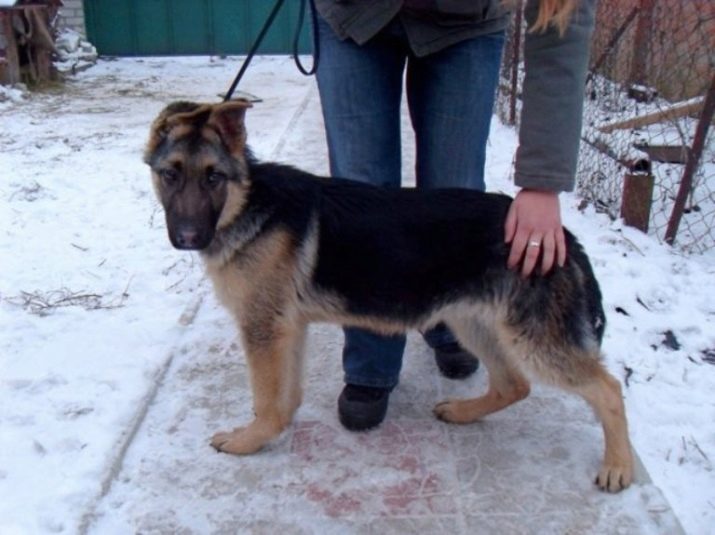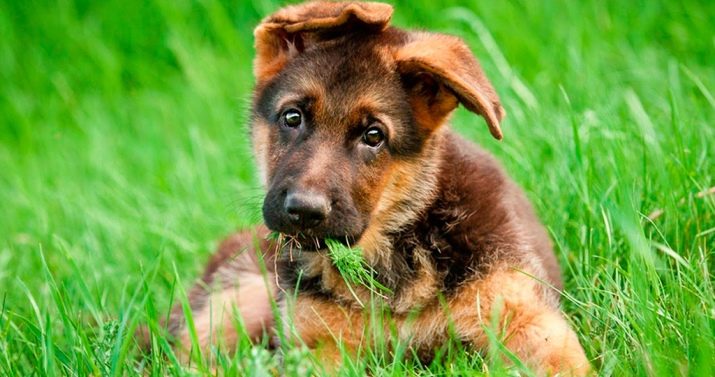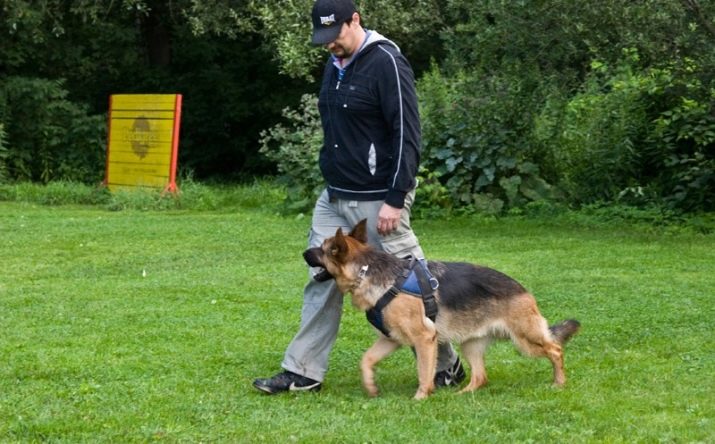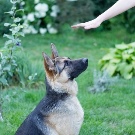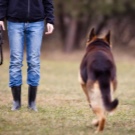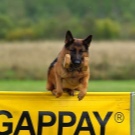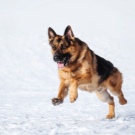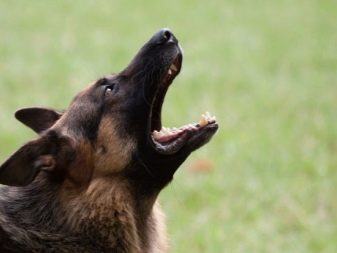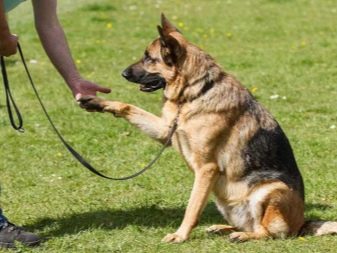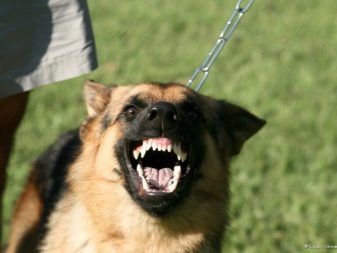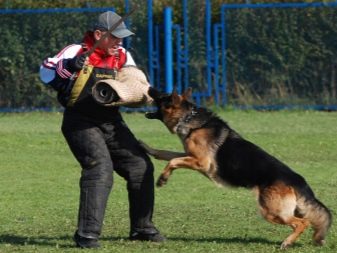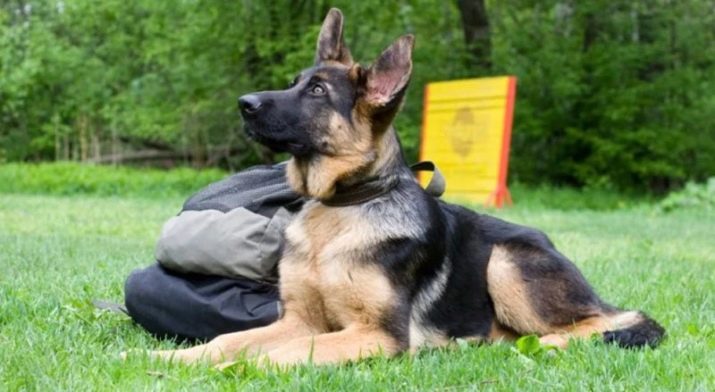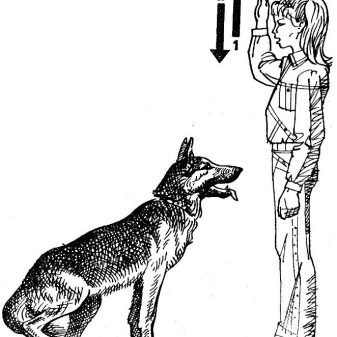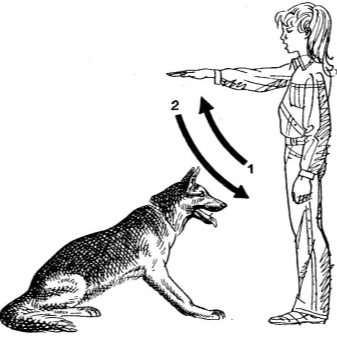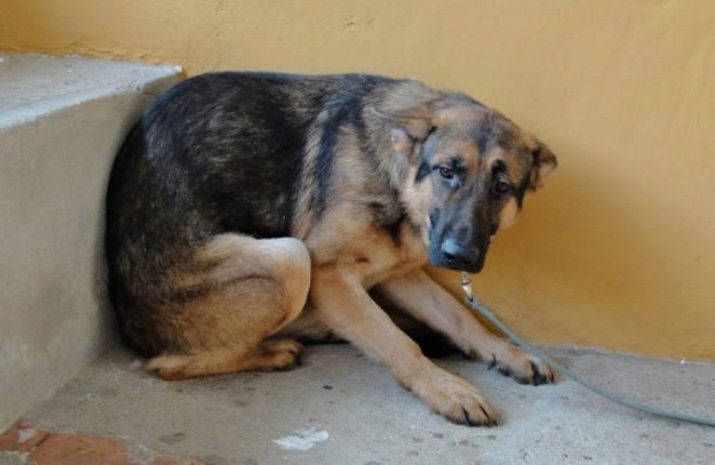The German Shepherd is a very clever and quick-witted dog, which is a good companion and protector for the whole family. Competent education and training will help grow a reliable friend out of a pet, who will understand the owner at a glance and demonstrate all the possibilities of his breed.
The nature and intelligence of the breed
To train the dog was correct, you should know about the characteristics of the nature of the selected breed. Each animal has its own behavioral traits that affect the training.
German shepherd belongs to the category of calm and balanced breeds of dogs that have high intelligence. The animal has such traits as courage, the ability to make decisions and adapt to difficult situations.
The “Germans” have received worldwide recognition as empathetic companions, who are happy to make a company to their owners. They are also loyal friends and get along well with all households, are peaceful towards children, and can act as a protector or guide dog.
This breed is easily trained, as the animal is strongly attached to people and with pleasure performs all the tasks. Thanks to their intelligence, they are able to instantly understand what is required of them in a certain situation.
The German Shepherd is a unique dog that can achieve perfection in almost any branch of dog training. Animals are often used in the following areas.
- Guard duty. In the blood of the breed there is a distrust of outsiders, so they successfully protect the objects assigned to them.
- Search and rescue service. A good nose allows dogs to find people in the rubble and in other places.
- Shepherd's service. The "Germans" qualitatively perform the role of an assistant shepherd.
- Bodyguard. Sheepdog is able to protect its owner and acts as a sensitive defender.
- Military service.
- Search for drugs and explosives. This breed is often used in public services.
- Border Service.
- Police.
The versatility of dogs is caused by their flexible psyche along with exemplary physical training. The German Shepherd is distinguished by indefatigability, a high degree of endurance, it is not afraid of cold or rain, and it can also perform assigned tasks for a long time. Thanks to all these factors, the breed is always present on any training site, because no one is going to start such a dog for lying on the couch.
At what age can you start learning?
The German Shepherd Dog should be trained from day one, as soon as the puppy appeared in the house. The young shepherd should start to get used to its name, place, elementary commands and place for the toilet. To the number of simple commands refers to "me", "fu." Later, you can proceed to other major teams, along with the correct behavior in different situations.
More serious training should be carried out when the dog is 6 months old.
Experts recommend using the help experienced instructorwho is engaged in group workouts or individual.
Fundamental rules
Before you get a puppy, the owner must accept the fact that training for a dog is an essential activity that can be compared to attending a kindergarten or school. Training is important not only for the dog, but also for the person, since an ill-bred dog can cause many problems.
Despite the fact that the German Shepherd is naturally a clever dog, it cannot by itself become obedient and educated and will perform various actions due to the needs of the environment. The owner must teach his pet key teams with which he can interact with his four-legged friend.
By training your pet correctly, the owner ensures safety not only for himself, but also for those around him.
Even doing training on their own, the owner of the dog will be able to correct the abnormal behavior of the dog, to work on enhancing the developed abilities. During training, the teacher and his student learn to trust, understand, and anticipate each other's behavior. After some time, both parties will learn to understand each other almost at the telepathic level.
Some people mistakenly believe that dressura is exhausting an animal. This is not true if you approach the process correctly. With the right approach, the “Germans” rejoice at new knowledge, because while learning, the dog fulfills its mission - to be useful to humans. This is happiness for the German Shepherd, which was bred in order to serve the people.
If the owner has never encountered the training of service breeds of dogs, you will need to take the help of a professional dog handler who will teach you how to properly handle the animal. An experienced instructor in dog training knows all the features of the breed, explains the principle of training to a beginner, and helps to get a well-behaved pet.
Before training, you should be familiar with such a concept as reflexes, which are the animal's response to stimuli.
Understanding the principle of such a term, one can understand the meaning of training. After all, the whole training is built on reflexes.
There are two types of reflexes: unconditional and conditional.
The first option is a congenital reaction of the animal. Here you can put security, hunting instincts, food, sex, defensive reactions. When teaching new skills, the trainer will use the food reflex, rewarding his student for a correctly completed task.
If the guard and defensive reflexes are well developed in an animal, this is also taken into account. Such representatives successfully manifest themselves in the guard-guard service.
Conditional reflexes are called reactions that are acquired by a dog throughout its life. In simple terms, this is a relationship that is created in the dog’s head while working with a person. When the owner encourages his pet to perform the task correctly, the reflex will look like this: completing the task - goodies - pleasure. In the opposite direction reflexes also work. For the wrong behavior overtakes the punishment that causes discomfort in the animal.
Any training, even initial, is built on the use of unconditioned reflexes to develop conditioned. Puppies that have innate food reflexes will try to get treats from the hands of their owner, following the instructions. The trainer, on the other hand, teaches the pet a certain skill, using food as motivation. Treating a dog, he develops conditioned reflexes in her.
Having settled in my house a little puppy, you need to remember that in the future the baby should become an educated dog. To achieve good results, you should remember three rules.
- Discipline. Many owners make concessions to their little friends and allow them more than they should be. This is not to be done, since every act must be tried on on an adult dog.If a small puppy is cute lying on the couch, then not everyone will be delighted and affection for an adult dog. The fact that it is impossible for an adult dog should not allow a small one.
- Promotion. It is necessary to treat the baby with care and guide him, to praise for properly performed actions. No need to be strict. It is best to teach teams in the form of games. The animal feels like a child. Therefore, you need to praise your four-legged friend for the fact that he went to the toilet in the right place, with success in the team, after eating.
- Schedule. Feeding should be done at the same time and only from the bowl. A dog must have its own place to eat. The regime will make life easier in the future, as it does not need to collect food debris throughout the house.
Raising puppies
Training at home should be conducted from the first day after the puppy in the house. Enter classes need to gradually, as the German shepherd grows up.
1-2 months
The first team, which must learn the puppy "German" - training for the name. When accustomed to the nickname, you need to remember that you can not change it. In order for an animal to react to it, you need to call the dog always the same.
It will also require training to the collar and leash, muzzle. The baby should get acquainted with these accessories as soon as possible so that in the future there will be fewer problems with such a question. When meeting with the collar, it is important not to scare the puppy. At first it is worn for a couple of minutes a day, after which the duration of the socks is increased. The leash and muzzle are taught in a similar pattern, walking with the baby first in the apartment.
Since small dogs have not had time to get vaccinated, they cannot be walked with.
For this reason, the toilet of the baby will also be located in the house. It is necessary to teach a little friend to discipline immediately, taking it after feeding or drinking in the allotted place. If the owner noticed that during play the puppy began to behave anxiously and to sniff out something, this is also a sign that he is looking for a place to use the toilet. After the successful completion of the affairs of the baby must be praised.
If the kutenok did his business in the wrong place, you can poke him a little and show him where he should have gone to the toilet. An important rule: such manipulations can be carried out immediately after the accomplished. After some time, the dog no longer remembers what it has done and for which it is now being scolded.
3-4 months
During this period, you can accustom the dog to the main teams. Each owner should remember the following rules:
- you can not blame the four-legged friend for the fact that he does not execute commands;
- good habit is patience, with its help you can succeed and win the trust of an animal.
You can study the following list of commands.
- "To me". When calling up an animal, you need to use sweets. After the dog completes the task, it is treated. It is strictly forbidden to use this command in order to scold an animal. "To me" should be used only in a positive way. So the dog will willingly carry out the instructions of its owner.
- "A place". To raise a puppy, he must be taught to such a team, regardless of where the dog will live: in an apartment or in a private house. She must have her own place where she will go on command implicitly. You can accustom with delicacies. In place you need to put a treat and send a dog there. After some time, the baby will be sent to the right place. This command should be spoken whenever the owner leaves home.
- "Fu". This is an important command that should be pronounced in a stricter voice. The animal must understand that the owner is dissatisfied with his behavior, so you can slap a puppy a little. You can not beat the dog, pronouncing this command. Sheepdogs are very smart, so they quickly understand what is required of them.
Working out basic teams with a dog allows in the future to walk around the street without any problems and to master new teams in the presence of other stimuli (dogs, people).
5-6 months
In this age group, puppies, which are already considered teenagers, are trained in skills that help develop endurance. Such teams can be honed at the age of 7-8 months and up to a year. As usual, promotion is applied.
You need to train your pet commands "next", "sit", "lie down", "stand." These messages are carried out until the moment when the owner does not say “walk”. Classes are held first for a few seconds, after which the duration of the training increases.
You can also start the exercises with obstacles. In this regard, the measure should be respected, since The backbone of the dog is not fully mature and can be harmful to him.
In the form of a game when walking you can throw a stick and ask the dog to bring it. Since the “German” wishes to please his master, he will bring it with pleasure. When performing a command, be sure to praise your pet.
Classes should be held every day.
Every day you need to allocate time for training your pet. Start training should not be postponed. Immediately you need to start raising a little friend so that he quickly remembers and perceives everything.
Dog dressing is a mode and lifestyle. If you do not use this rhythm immediately, the animal will get used to another, and retraining an adult animal with established habits is much more difficult.
How long does the training of a “German” puppy take?
The process of training continues in the period from 2-12 months. At this time, the dog requires the utmost attention from its owner. The owner’s responsibility depends on how well the animal is raised. From the stamina and calmness of the owner depends on the nature of his dog.
How to train an adult dog?
To train an adult dog is a little more difficult than a puppy, since the animal has already formed according to its habits and it is more difficult to retrain it. But the German Shepherd captures everything literally on the fly, and if there is trust between the owner and the pet, the learning process will be easy.
It is important to be patient and calm while training.
Each dog must complete an early course. This is a general course of training, which includes a mandatory list of commands that allows the dog to be raised in society and to behave adequately with different stimuli.
List of teams for the general course of training.
- "Beside". The dog must move near its owner, regardless of the situation. Deviation is allowed forward to half the body of the animal. Similar requirements are made when moving without a leash. When the owner stops, the dog should sit next to each other. The movement of the animal is made on the left side of the person.
- Demonstration of bite and loyalty to the muzzle. A bite is required at exhibitions, as well as during visits to the vet.
- “Sit”, “Lie down”, “Stand”.
- "To me".
- "A place".
- "Aport". The execution of this command is carried out together with the command "give".
- "Walk". When submitting this instruction, the animal can freely move around the adjacent territory.
- Reaction to feed scattered on the ground. The dog should not lift food from the floor.
- Attitude to shots and loud sounds.
- "Fu".
- Overcoming obstacles. It is carried out together with the “forward” and “barrier” teams, during which the animal jumps over an obstacle.
Each person decides which team his pet will need. However, one should always remember that the German Shepherd should be trained, as it was bred as a service breed. Officially, the “Germans” are recognized as service dogs in Russia, Belarus, Ukraine and are potentially dangerous.
The appearance of destructive individuals in society is unacceptable, since it carries a danger to society.
How is the training of teams of adults.
- "Sit". It is done with a little effort. You will need to gently press the dog on the croup, saying the command "sit." When the animal sits, you can treat him to a treat. Some owners bring a treat over the dog's head and tilt it back a little. The dog, trying to follow the meal, will automatically sit down. It is necessary not to forget to pronounce the command and always praise the pet after the performance.
- "Lie down". Produced by a similar technique, only you need to press on the shoulders of the animal. You can use a leash with which the dog is attracted to the ground, enticing with a treat.
- "Give me a paw." Many people believe that this is the simplest team that most owners use for entertainment. It is performed from a sitting position. The dog should take a paw and say aloud the command. After this, the pet must be praised and treated to a treat. After a few procedures, the animal will understand what is required of it, and will happily give its paw to a person on its own.
- Teach the team "voice" can also be with a treat. The food is clamped in the hand in such a way that the animal sees it, but cannot take it. You can press his finger and place your hand at the level of the shoulders or face. The dog will not understand why it is teased by food and does not give, and will give a voice. In this case, be sure to say the command out loud.
- "Aport". Training can begin at the moment when the pet is set to play and brings a wand. Throw the toy must first be a short distance, after which the pet should be called to him, calling him by name and pronouncing the command. Taking the toy from the "German", you need to praise him and repeat the process again.
- Weaning from raising food from the ground is primarily for safety purposes. An animal that eats food scattered on the street may be poisoned. Therefore, this command should work perfectly. You can put peppers in the food so that the dog understands that what is chosen can be dangerous. In this case, you should use the word "throw."
Service dogs must be taught to professional teams. Most sheepdogs give birth to guard. To fulfill the instructions say the dog "guard." After this, the animal should not allow anyone to approach the object entrusted to it.
"Footprint" is used to search for hidden objects. It is also used in service dog breeding.
"Take" or "face" is used to attack the attacker. The course is called ZKS (protective and guard duty) and should be conducted only by a professional canine. At the same time, the skills of “fu,” “let go,” and “calmly” are learned.
If the "German" is acquired as a security guard of a home or other object, it is imperative to contact a dog handler who will work out the basic commands, check the skills and abilities of the shepherd dog.
Types of teams
There are two kinds of commands: voice and gestures.
During voice commands, all orders should be given in a clear and distinct voice. It is important to pronounce them with the same intonation and only once. If you work "to me", you can repeatedly call the dog by name, but the order itself is given only once.
Dogs are not able to make out specific words, but can memorize the number of syllables along with the pronounced intonation. For this reason, dog breeders advise to speak teams with the same intonation and not distort their names.
Some people practice with their pets in German. This method is used during the sports training of the international system, as well as to prevent a dog from being controlled by a stranger.
Issuing orders with gestures is that the owner does not say aloud the command, but only shows a certain gesture. From the side it looks quite impressive and carries utility. Over time, the shepherd will age and its hearing will not be the same.With the help of gestures, you can facilitate the process of understanding between the pet and its owner.
How gestures are made.
- "To me". The hand should be parallel to the ground. The palm should look down. When submitting an order, the hand should be sharply lowered to the thigh. Cotton is not allowed.
- "Walk". With the palm down, you should move your hand forward.
- "Sit". The arm bent at the elbow should be at chest level. The palm is then turned onto the animal.
- "Lie down." The hand is at the level of the chest, the palm must face the ground.
- "Stand". The hand is at chest level, the palm looks up.
All gestures must be carried out using the right hand.
Training with the help of gestures can be started only after the shepherd has learned all the exercises with voice.
Frequent mistakes
Each person who becomes the owner of a puppy of a German shepherd, dreams that his pet in the future becomes a smart and indicative dog for example. Everyone wants his animal to strictly follow the instructions and have a high degree of discipline. Despite the fact that everyone dreams of this, not everyone spends enough time and effort on this.
Some owners feed their pet, go for a walk with him, but ignore the training. Disorder in the home discipline also damages the process of raising a dog. If a four-legged friend will sleep where he pleases and eat food in different places, he will not be able to behave decently on the street. To avoid such situations, you should familiarize yourself with common errors.
- Physical punishment. No severe penalties are allowed.
- Conducting rare classes. Dressura should be made on a daily basis. Only with a serious and responsible approach can the desired result be achieved.
- Lack of attention from the owner. To grow a faithful friend, you need to give him enough time, not to ignore his friend. This applies not only to babies, but also adults.
- Lack of mental and physical stress. Only if the owner learns his pet will he be able to get a well-educated and cultured dog.
- Persistence in prohibitions. If the shepherd can not lie on the couch, this ban should be permanent. No exceptions are allowed. If the owner can not show stability, the animal can also carry out orders on the mood.
On how to start training a puppy, see the following video.

